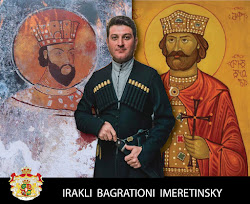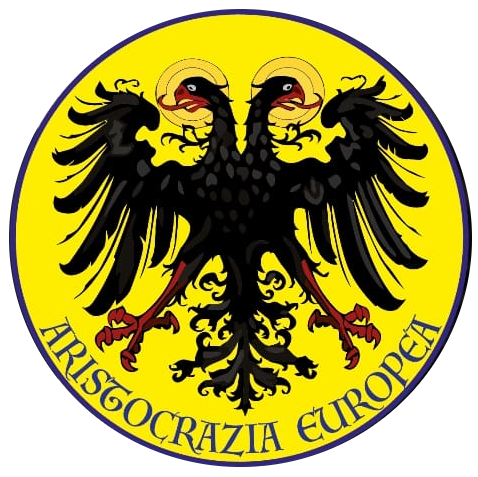The Royal Archconfraternity of the Holy Cross of Georgia (or Ancient Royal Christian Orthodox Ecumenical Chivalric Brotherhood of the Holy Cross Tadzrelebi of Bolnisi) is a chivalric Order, among the few to have come to the present day, without having suffered contamination of its structural or ritual nature and still operates under the protection of the Sacred Orthodox Church and of the Royal House BAGRATIONI Imereti.
The emblem of the Royal Archconfraternity consists of the Bolnisi Cross, which is a symbol of the cross, taken from a 5th century ornament at the church of Bolnisi Sioni, which was later used as the national symbol of Georgia.

The Bolnisi Cross is a variant of the Templar patent cross, which gave rise to further variants of crosses, such as the Maltese Cross, the Cross of the Knights Hospitaller, the Black Cross of the Teutonic Order, as well as the Cross of St. Lazarus or the Cross of Iron used by the German military.
The highest merit that the Royal Confraternity grants is the Holy Cross of Georgia, represented by the Cross of vine branches, better known as the Cross of Saint Nino or the Georgian Cross, which is the most important symbol of the Georgian Orthodox Church.
Georgian knightly decorations are traditionally blessed and delivered on the occasion of the most important Orthodox religious holidays, especially those dedicated to the various Holy Kings of Georgia, in particular to the Holy Queen Tamara, a woman historically known for being a wise civil statesman as well as a skilled military strategist.
According to tradition, the Holy Cross of Georgia was brought to the country that gave it its name in the fourth century by Santa Cristiana, evangelizer of the ancient kingdom of Iberia, accompanying her in her mission of evangelization; the cross is distinguished by the slight downward curvature of the horizontal arms. Historical sources report that the Saint received the cross from the Virgin Mary and surrounded it with his own hair.
The cross was later kept at the Svetitskhoveli Cathedral in Mtskheta until 541. Due to the Persian invasions it was then moved to Armenia, where it remained until 1124, when King David IV took the city of Ani from the Muslims and brought back the relic in Mtskheta. At the beginning of the 14th century, the Georgian ruler Vakhtang III had a reliquary forged to contain the cross. It was decorated with images taken from the hagiographies dedicated to Santa Cristiana (Nino).
During the twenties of the eighteenth century, when Georgia found itself having to face the Persian and Ottoman invasions, the relic was moved to Ananuri, in a mountainous and safe area. From there, the Georgian bishop Timothy took her to Moscow, where the emigrant prince Bakar resided. Later the Georgian king Heraclius II tried to recover the relic from Bakar’s family, but to no avail. In 1801 Bakar’s nephew, George XII, gave the cross to the Russian Tsar Alexander I, as the latter had promised to liberate Georgia from the Muslim Turks. In 1802, on the occasion of the incorporation of Georgia into the Russian Empire, the relic was returned to the veneration of the Georgian people. It has since been kept in Tbilisi’s Sioni Cathedral.

The Sacred Cross of Georgia is therefore a very prestigious merit of incalculable historical value, it is of Caucasian, Eurasian tradition, and granted by the Royal Archconfraternity of the Holy Cross of Georgia (of Jerusalem and Constantinople), historical institution of chivalry, under the official protection of the Holy Orthodox Church and the millennial Royal House BAGRATIONI Imereti; the institution of chivalry originates from the Georgian knights Tadzrelebi, famous for their indomitable courage, who fought at the Crusades and the Holy Cross of Georgia is granted only to selected candidates, for real and proven cultural and artistic, political and diplomatic, social and charitable merits towards the Georgia and the Georgian Orthodox community.
THE ROYAL HOUSE BAGRATIONI IMERETINSKY
The Kingdom of Imereti was a Georgian monarchy established in 1455 by a member of the house of Bagrationi when the Kingdom of Georgia was dissolved into rival kingdoms. Before that time, Imereti was considered a separate kingdom within the Kingdom of Georgia, of which a cadet branch of the Bagrationi royal family held the crown. This process started in 1260 after David VI revolted against Mongolian rule and fled to Abkhazia. This was the result of the Mongolian conquest of Georgia during the 13th century which decentralized and fragmented Georgia, forcing the relocation of governmental centres to the provinces.
Kings of Imereti
First House of Imereti
David I (1258–1293)
Constantine I (1293–1326)
Michael (1326–1329)
Bagrat I (1329–1330)
Vacant (1330–1387)
Alexandre I (1387–1389)
George I (1389–1392)
Vacant (1392–1396)
Constantine II (1396–1401)
Demetrius I (1401–1455), only recognized as Duke by Alexander I of Georgia
Second House of Imereti
Demetrius II (1446–1452)
Bagrat II (1463–1478)
Alexander II (1478–1510)
Bagrat III (1510–1565)
George II (1565–1585)
Leon (1585–1588)
Rostom (1588–1589, 1590–1605)
Bagrat IV (1589–1590)
George III (1605–1639)
Alexander III (1639–1660)
Bagrat V (1660–1661, 1663–1668, 1669–1678, 1679–1681)
Vakhtang Tchutchunashvili (1661–1663)[4]
Archil (1661–63, 1678–79, 1690–91, 1695–96, 1698)
Demetre (1663–1664)[4]
George IV (1681–1683)[4]
Alexander IV (1683–1690, 1691–1695)
Simon (1699–1701)
George V (1696–1698)[4]
Mamia (1701–02, 1711, 1713)[4]
George VI (1702–1707)[4]
George VII (1707–11, 1712–13, 1713–16, 1719–1720)
George VIII (1716)[4]
Alexander V (1720–1741, 1741–1746, 1749–1752)
George IX (1741)
Mamuka (1746–1749)
Solomon I (1752–1766, 1768–1784)
Teimuraz (1766–1768)
David II (1784–1789, 1790–1791)
Solomon II (1789–1790, 1792–1810)
Heads of House of Imereti after 1815
Since Solomon II of Imereti had no sons, he proclaimed Prince Constantine, son of king David II of Imereti, and his male-line senior descendants as heirs to the throne of the Kingdom of Imereti.
Hereditary Prince Constantine (I) (1815–1844), son of king David II
Constantine (II) (1844–1885), son of Prince Constantine (I)
Mikheil (1885–1888), son of Prince Constantine (II)
George (I) (1888–1932), son of Prince Mikheil
George (II) (1932–1972), son of Prince George (I), had no issue
Constantine (III) (1972-1978), young brother of George (II)
Princess Thamar (would have been Head of House from 1978), daughter of Prince Mikheil Imeretinsky (1900-1975), younger brother of Constantine (III)
After the death of Hereditary Prince Constantine (III) (1898–1978), because the male-offspring of this branch came to end, the headship of the House of Bagrationi-Imereti transmitted to Prince Irakli Bagrationi (1925–2013), son of Prince Grigol, the male-line descendant of Prince Bagrat, younger brother of King Solomon I of Imereti (1752–1784).
Irakli Bagrationi (1925–2013)
David Bagrationi (born 1948) (2013–2017), transmitted his headship to his son
Irakli Bagrationi (born 1982) (from 2017)
The Bagrationi are the oldest sovereign, princely and royal dynast in all of Christendom that ruled Georgia and the Caucasus for over 1500 years. The family is very large and there was no lack of disagreements between the different branches, which produced at least three pretenders to the virtual throne of Georgia.
Prince Bagrationi of royal blood is HRH Irakli Imereli, direct descendant of the last Georgian rulers on the throne of the kingdom of Imerezia, Grand Prince of Imereti and Amiereti, Lord of the Abkhazians, Ranians, Kakhetians and Armenians, Servant of God and Defender of Holy Orthodox Apostolic Church of Georgia.
The illegitimate pretenders to the throne are Nugzar Bagrationi-Gruzinski, who is simply the son of the widow of the last Prince Gruzinsky but not of the Prince himself, and for this reason he has no rights to claim any royal right. In confirmation of this, Nugzar Bagrationi-Gruzinski’s refusal to undergo the DNA test.
The youngest pretender to the Throne, David Mukhraneli, is a true Bagrationi but he is only a Most Serene Highness (and not a Royal) because the Bagrationi Mukhraneli princes were never King of Georgia. In fact, in 1942, his grandfather proclaimed himself heir to the throne, with the decisive and instrumental political support of Hitler and Mussolini, in an anti-Soviet function.
The only true Bagrationi prince of royal blood is H.R.H. Irakli Imereli, direct descendant of the last Georgian rulers to the throne of the kingdom of Imerezia. It is only he, a young engineer and agricultural entrepreneur, who studied first in a convent and then as an officer at the military school, who has all the credentials and the consent of the majority of Georgian nobles and monarchists.
The situation is of public domain in Georgia and reverberates in international relations, so that both Nugzar Bagrationi-Gruzinski and David Mukhraneli do not have regular diplomatic representation, like any other genuine Royal House perceived as legitimate.

The delegation of the Bagrationi Imereti Royal House of Georgia, on the other hand, has a collective of over two hundred authoritative people, proud to represent the Royal House which is governed by a fellowship of noblewomen, which organizes, under the protection and in collaboration with the Orthodox Church, numerous and frequent cultural and social activities.
In Italy lives only two true Bagrationi – the only ones to be Catholic – both with Italian citizenship: SAS the Princess Ketevan Bagrationi Mukhrani Orsini d’Aragona, Ambassador of Georgia to the Vatican and HRH the very young Prince Nick Bagrationi Betaneli Bagration, descendant of the mythical Tsarist general Russian Pyotr Bagration, then from the dynasty of the Kings of the ancient Georgian kingdom of Cartalia.
Thus declares Count Nikoloz Vardanidzev Tavadishvili, high representative of the Royal House of Bagrationi:
“Our spirit is strongly traditional, Christian and patriotic, and we are very faithful to our Apostolic Orthodox Church, to our Holy Patriarch Ilia II and to our Eminent Bishop Abram, Metropolitan of Western Europe. We carry out promotional activities to support cultural and commercial exchanges, and tourism; to make known our literature and art, our wine, our typical cuisine and our folkloric dances. But the Knights of the Holy Cross are above all defenders of the Christian Civilization and of the persecuted Christian brothers in the world. And with a sense of justice and solidarity, we are also active with the “National Volunteers of the Holy Cross” who, in Italy, deal with social assistance to needy families (both Italian and foreign), first aid and civil protection. At the moment, for example, we are actively engaged in raising funds and material aid for innocent Ukrainian civilian refugees from both sides of the conflict. For us, the insignia of the Holy Cross have a great symbolic and spiritual value, which is why we only grant them to those who are truly worthy and deserving “
COUNTESS MANDILOSANI LALI PANCHULIDZE AZNAURI
– Present-day representative of the Georgian royal tradition in Europe –
Countess Mandilosani Lali Panchulidze Aznauri represents the BAGRATIONI Imereti Royal House in Monaco, in Switzerland, in Italy, in San Marino, at the Vatican and the Order of Malta, as well as at the European Parliament.
Born in 1985, Mandilosani Lali Panchulidze Aznauri, got graduated in literature with a master in pedagogy, and is currently a business consultant and public relations officer. The Countess is considered a prominent personality in international cultural exchanges involving the BAGRATIONI Imereti Royal House and the Royal Archconfraternity of the Holy Cross of Georgia.
Countess Mandilosani Lali Panchulidze, after having served as a teacher and having been a bank employee, had the opportunity to work and get to know in depth the Eurasian international trade sector of fashion, design and luxury goods. She currently deals with communication, promotion, event management and video-photographic services.

Lali Panchulidze is President of the Italy-Georgia-Eurasia Christian ecumenical association which is interested in history, culture and identity, in the organization of tourist trips in the Caucasus and in the promotion of the famous Georgian wines, at the same time, she is Vice-President of the association European Aristocracy, with responsibility for international relations. European Aristocracy (Aristocrazia Europea) is an interesting institution, active in various cultural initiatives and it is an association that is essentially carrying out in Italy, in a private way, something very similar to the function of the archive, that was once carried out by the suppressed Italian Heraldic Register. Countess Mandilosani is also passionate about art, poetry, classical music, traditional and folkloristic dances.

SOURCES:
https://www.wikiwand.com/en/Kingdom_of_Imereti
https://nobiltaeuropea.blogspot.com/2021/?m=1
https://www.notiziarioaraldico.info/2022041918181/conferimenti-della-santa-croce-di-georgia-2022/
https://it.wikipedia.org/wiki/Bagration

